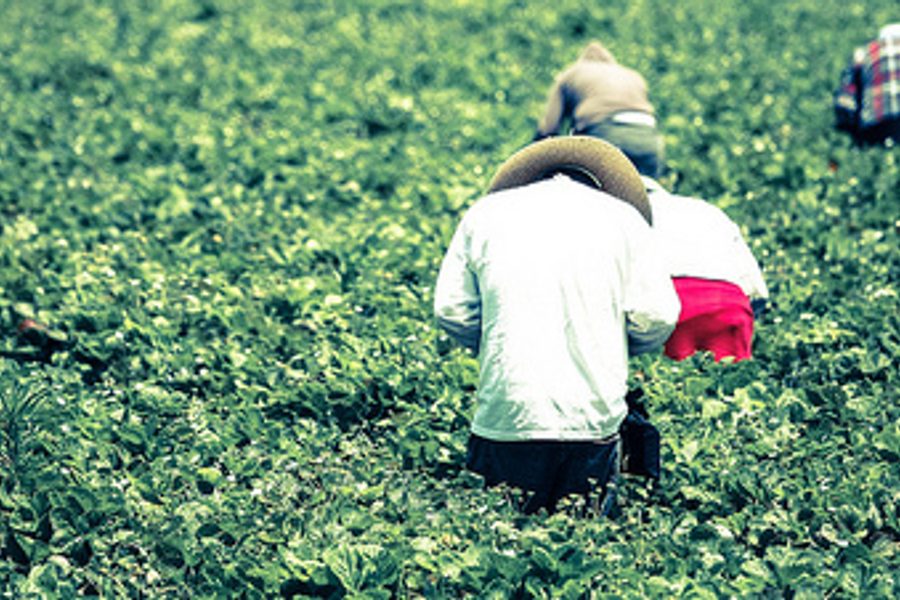
No matter how good your next meal tastes, it’s likely it made society ill.
A new analysis by the Pesticide Action Network North America (PAN) draws a disturbing connection between pesticides in our food system and serious health problems among women and children. The report reviews empirical research linking agricultural chemicals to birth defects, neurological disorders, childhood cancers and reproductive problems.
Some of these chemicals make their way into the foods we eat, but they are more acutely concentrated in the environments surrounding farmlands. Children in or near farming areas can be exposed through myriad channels, from contaminated soil to the air in playgrounds.
But children in farmworker communities are especially at risk. While the report confirms the growing public concerns about health risks permeating our food chain, it also shows how socioeconomic inequalities can shovel many of the worst effects onto exploited, impoverished workers.
There’s been much public debate over the importance of organic produce, sustainable farming and regulating genetically modified foods–usually spurred by concerns over consumer health or animal rights. We hear less about the safety concerns that affect the workers who handle our fruits and vegetables before anyone else. For many Latino migrant workers, there’s no equivalent of a comprehensive safety label – no option to avoid the ubiquitous poisons in the field. Many worry that to complain about working conditions would mean being fired. Others simply – and quite reasonably – have little faith in the anemic government regulatory systems.
PAN cites research showing that pesticide injuries are prevalent among agricultural workers. Various studies cited in the report also suggest an epidemic of chemical “drift” from fields into nearby homes and neighborhoods. According to a 2009 report by the advocacy groups Earth Justice and Farmworker Justice (FWJ), “a growing number of epidemiological studies link pesticide drift to specific adverse health effects in humans, including autism spectrum disorders, Parkinson’s disease, and childhood acute lymphoblastic leukemia.”
While the problem is politically invisible, the effects are all too apparent. The PAN report describes the experience of Ana Duncan Pardo, a community health activist in North Carolina, who had a jarring encounter with farmworker families:
Within five minutes I had noted multiple cleft palates and several children with apparent Down Syndrome…. It was shocking and disturbing to walk into a room with a group of parents and children that easily represented three to four times the national average for birth defects.
The effect is likely compounded by the widespread use of child labor in agriculture – children barely in their teens can legally work on farms. That puts kids in daily contact with toxins that could irreparably harm their brains and bodies.
A FWJ briefing paper points to a history of vast dissonance between the federal regulation of harmful pesticides for heavily exposed workers, and parallel standards for the general public. The Federal Insecticide, Fungicide, and Rodenticide Act establishes public health-based safety protections, for example, but environmental advocates point out that farmworker families’ health vulnerabilities are neglected and essentially ignored in regulatory assessments of the social costs of industrial pesticide use.
Children of farmworker families are left with far weaker protections despite their special vulnerability. Despite some restrictions on child workers handling pesticides, according to FWJ, “Children under 16 can still handle Category III or IV pesticides even though the chronic hazards associated with these chemicals include ‘potential neurotoxicity, reproductive toxicity, endocrine disruption, and carcinogenic effects.’”
Even if they don’t work in the fields, the children of farmworkers are not necessarily safe in their own homes. Virginia Ruiz, FWJ’s director of Occupational & Environmental Health, explains that farmworkers working with pesticides carry “take-home residues” on their clothes and skin. While safety warnings recommend avoiding physical contact with contaminated workers, Ruiz says, “It’s sort of an unrealistic expectation of people to refrain from hugging their children and other family members as soon as they get home.”
The PAN analysis urges consumers and parents to take action for stronger safety protections. These could include mandates to phase harmful pesticides out of the market, and promoting pesticide-free school lunches and playgrounds.
Nonetheless, the battle against the pesticide threats on farms can’t be limited to the consumer end of the food chain. Farmworkers need to be engaged as stakeholders in pursuing just solutions to the unique risks posed to their communities. Farmworkers have played a leading role pushing for tighter EPA regulations as well as grassroots efforts to mobilize communities against pesticide drift. For example, a community-driven campaign in California’s Central Valley led to the creation of buffer zones to keep pesticide contamination away from sensitive locations like schools, farmworker camps and residential areas.
Kristin Schafer, coauthor of PAN’s report, tells Working In These Times, “Farmworker families were essential to the success of these efforts – some working behind the scenes, others speaking out to demand protections for their families.” She adds that environmental monitoring projects in other farmworker communities have provided opportunities for laborers “to document pesticide drift from neighboring fields, and use [this] as scientific evidence to advance these protections.” Community activists are now pressing California’s regulatory authorities to transition farms away from pesticides and toward greener alternatives.
Still, in every policy debate, farmworker families will face tremendous barriers of race, language ability, political disenfranchisement and poverty. Those aren’t chemical threats, but they constitute the climate of oppression that blankets the nation’s farms, and that corrosive cloud is now drifting into all our communities.
Michelle Chen is a contributing writer at In These Times and The Nation, a contributing editor at Dissent and a co-producer of the “Belabored” podcast. She studies history at the CUNY Graduate Center. She tweets at @meeshellchen.








